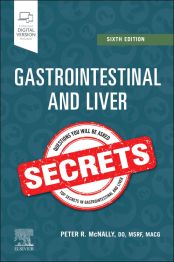For more than 30 years, the highly regarded Secrets Series® has provided students and practitioners in all areas of health care with concise, focused, and engaging resources for quick reference and exam review. Gastrointestinal and Liver Secrets, 6th Edition (formerly known as GI/Liver Secrets), offers practical, up-to-date coverage of the full range of essential topics in this dynamic field. This highly regarded resource features the Secrets’ popular question-and-answer format that also includes lists, tables, pearls, memory aids, and an easy-to-read style – making inquiry, reference, and review quick, easy, and enjoyable.
Key Features
- The proven Secrets Series® format gives you the most return for your time – succinct, easy to read, engaging, and highly effective
- Fully revised and updated throughout, making it an excellent resource for understanding the physiology and therapy of hepatic and digestive disease
- New chapters on Microbiome and Surgery for Inflammatory Bowel Disease
- Top 100 Secrets provide a fast overview of the secrets you must know for success in practice and on exams
- More than 250 full-color illustrations, endoscopic images, micrographs, and algorithms, plus videos and clinical vignettes online
- Bulleted lists, mnemonics, practical tips from global leaders in the field – all providing a concise overview of important board-relevant content
- Portable size makes it easy to carry with you for quick reference or review anywhere, anytime
- An eBook version is included with purchase. The eBook allows you to access all of the text, figures, and references, with the ability to search, customize your content, make notes and highlights, and have content read aloud
Author Information
By Peter R. McNally, DO, MSRF, FACG,, Chief, GI/Hepatology, Evans Army Hospital, Colorado Springs, Colorado, American Board of Internal Medicine Certification in Internal Medicine American Board of Gastroenterology Certification in Gastroenterology, USA
Section 1 esophagus
1. Gastroesophageal reflux disease
2. Esophageal causes of chest pain
3. Achalasia
4. Swallowing disorders and dysphagia
5. Esophageal cancer
6. Esophageal anomalies, infections, and nonacid injuries
7. Barrett esophagus
8. Esophageal and stomach pathology
section 2 stomach
9. Gastritis, peptic ulcer disease, nonsteroidal anti-inflammatory drugs, and helicobacter pylori infection
10. Gastric cancer
11. Thickened gastric folds
12. Gastroparesis
section 3 liver and biliary tract disorders
13. Evaluation of abnormal liver tests
14. Microbiome in health and disease
15. Antiviral therapy for hepatitis c
16. Antiviral therapy for hepatitis b
17. Autoimmune hepatitis—diagnosis
18. Autoimmune hepatitis—treatment
19. Primary biliary cholangitis and primary sclerosing cholangitis
20. Vaccinations and immunoprophylaxis in gastrointestinal and liver disorders
21. Pregnancy and liver disease
22. Rheumatologic manifestations of hepatobiliary diseases
23. Evaluation of focal liver masses
24. Drug-induced liver disease
25. Alcoholic liver disease, alcoholism, and alcohol withdrawal
26. Vascular liver disease
27. Metabolic-associated fatty liver disease (mafld): nonalcoholic fatty liver disease/metabolic dysfunction–associated steatotic liver disease (nafld/masld) and metabolic dysfunction–associated steatohepatitis (mash)
28. Overview of liver transplantation
29. Ascites
30. Liver abscess
31. Inheritable forms of liver disease
32. Liver histopathology
33. Hepatobiliary cystic disease
34. Gallbladder disease: causes, complications, and therapies
35. Endoscopic retrograde cholangiopancreatography plus sphincter of oddi dysfunction
section 4 pancreatic disorders
36. Acute pancreatitis
37. Chronic pancreatitis
38. Pancreatic cancer
39. Cystic lesions of the pancreas
section 5 small and large bowel disorders
40. Celiac disease
41. Crohn’s disease
42. Ulcerative colitis
43. Eosinophilic gastrointestinal diseases and eosinophilic esophagitis
44. Small intestinal bacterial overgrowth
section 6 colon disorders
45. Colon disorders and colon cancer
46. Constipation and fecal incontinence
47. Diverticulitis
48. Surgical considerations in inflammatory bowel disease and benign anorectal pathologies
49. Colitis: clostridioides difficile infection, microscopic colitis, and radiation proctitis/proctopathy
section 7 general symptoms and conditions
50. Upper gastrointestinal hemorrhage
51. Lower gastrointestinal tract bleeding
52. Occult and obscure gastrointestinal bleeding
53. Evaluation of acute abdominal pain
54. Acute diarrhea
55. Chronic diarrhea
56. Acquired immune deficiency syndrome and the gastrointestinal tract
57. Ischemic bowel disease
58. Nutrition, malnutrition, and probiotics
59. Small bowel and colon pathology
60. Foreign bodies and the gastrointestinal tract
61. Functional gastrointestinal disorders and irritable bowel
62. Endoscopic cancer screening and surveillance
section 8 multisystem manifestations of gi disease
63. Rheumatologic manifestations of gastrointestinal diseases
64. Dermatologic manifestations of gastrointestinal disease
65. Diseases of the appendix
section 9 gastrointestinal radiology
66. Plain film, barium, and virtual colonography
67. Interventional radiology i: cross-sectional imaging procedures
68. Interventional radiology ii: fluoroscopic and angiographic procedures
69. Noninvasive gastrointestinal imaging: ultrasound, computed tomography, and magnetic resonance imaging
70. Nuclear imaging
71. Endoscopic ultrasound
section 10 surgery and the gastrointestinal tract
72. Esophageal surgery
73. Surgery for peptic ulcer disease
74. Surgical approach to the acute abdomen
75. Colorectal surgery: polyposis syndromes, colorectal malignancies, and benign diseases
76. Gastrointestinal secrets: bariatric surgery
77. Minimally invasive surgery












